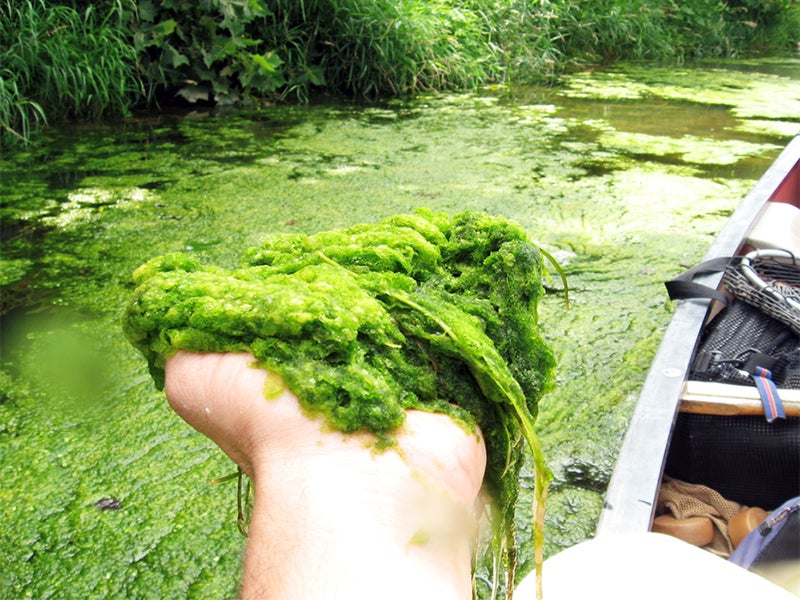EPA Fails to Protect Shenandoah River
Local groups challenge EPA’s approval of Virginia’s decision to not list the Shenandoah as ‘impaired,’ despite excessive algae blooms and nutrient pollution
Contacts
Phillip Ellis, Earthjustice, (202) 745-5221
,
Mark Frondorf, Shenandoah Riverkeeper, (571) 969-0746
,
Phillip Musegaas, Potomac Riverkeeper Network, (914) 806-0916
,
Stephan J. Kimm, Potomac River Smallmouth Club, (703) 928-5473
Today, three local citizen groups filed a lawsuit against the U.S. Environmental Protection Agency for the agency’s repeated failure to address the Shenandoah River’s increasing problem with algae blooms and pollution. Shenandoah Riverkeeper, Potomac Riverkeeper Network, and the Potomac River Smallmouth Club filed the suit and are represented by Earthjustice.
Agricultural runoff in the Shenandoah Valley are causing the algae outbreaks.
The algae blooms, caused by agricultural runoff in the Shenandoah Valley, interfere with recreational uses of the river, such as swimming, kayaking and fishing. They also harm native grasses and affect aquatic life.
“The Shenandoah is one of the most beautiful rivers in the country—and a popular recreation destination. But it’s threatened by the failure of state and federal authorities to stop excessive nutrients—and the algae they produce—from entering the river. We hope this lawsuit will change that,” said Mark Frondorf, Shenandoah Riverkeeper.
Alan Lehman / Potomac Riverkeeper Network
Aerial view of algae covering Shenandoah River at Harpers Ferry.
For years, Shenandoah Riverkeeper has been pressing Virginia’s Department of Environmental Quality to designate the river as impaired because of the algae blooms. The agency has refused, even as evidence of the impairment has grown. A recent report by the Environmental Integrity Project found that Virginia’s pollution management system allows agricultural operations to dispose of their manure by spreading it on fields that are already saturated with nitrogen, leaving the excess to run off of fields and fuel algae blooms in the river.
The lawsuit says EPA did not fulfill its duty under the Clean Water Act when it approved Virginia’s decision not to identify the Shenandoah River’s algae impairment on the state’s list of quality-impaired rivers and streams. EPA should have identified the Shenandoah River as impaired based on extensive data demonstrating that widespread algae blooms prevent the river from meeting Virginia’s water quality standards.
“The legal steps being taken today are required because the political will to do anything about the algae problems we see on the Shenandoah River seems to be lacking both in Richmond and by our federal regulatory agencies,” said Stephan J. Kimm, president of the Potomac River Smallmouth Club. “We wish to see our river returned to the condition it once was, a fishable, swimmable waterway, and enjoyable experience, unencumbered by the thick, extensive mats of algae we see today.”
Alan Lehman / Potomac Riverkeeper Network
Algae in the Shenandoah River.
Listing a waterway as “impaired” triggers a regulatory process leading to the imposition of limits on the amount of the pollution causing the impairment into the waterway. In this case, Virginia would be required to develop limits on the total amount of nitrogen and phosphorus being discharged into the Shenandoah that are protective enough to prevent algae blooms and improve water quality.
The lawsuit asks the court to order EPA to disapprove Virginia’s list of impaired streams, to identify the Shenandoah River as impaired by algae-fueling pollutants, and to establish the pollution caps needed to bring the river back into attainment with state water quality standards.
“Despite the years of growing evidence of impairment, EPA failed to take the action required by the Clean Water Act to limit the pollution causing these algae blooms,” said Jennifer Chavez, the Earthjustice attorney representing the river groups. “DEQ’s refusal to even evaluate this evidence to make an impairment determination is unacceptable—as is EPA’s failure to step in and perform its oversight duties as the Clean Water Act requires it to do.”

Additional Resources
About Earthjustice
Earthjustice is the premier nonprofit environmental law organization. We wield the power of law and the strength of partnership to protect people's health, to preserve magnificent places and wildlife, to advance clean energy, and to combat climate change. We are here because the earth needs a good lawyer.
